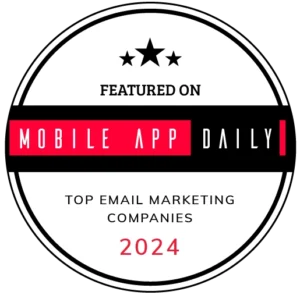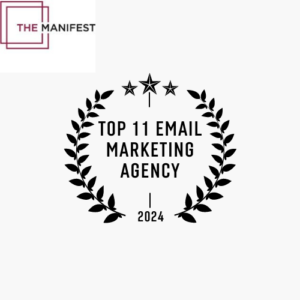One of the best methods for generating leads in the cutthroat world of digital marketing is sending cold emails. A well-written cold email can draw in potential customers and partners even in the age of social media platforms. If you’re looking for unique methods still effective in today’s era, you might gain a lot of insight through this quick read.
Comprehending Cold Emails
Cold emails are unsolicited messages sent to potential leads without prior contact. In contrast to spam, cold emails are personalized for each recipient and intended to build a deep relationship. The main objective is to present your offering, grab the recipient’s attention, and motivate them to take a specific action. This can include making an appointment, signing up for a demo, or visiting your website.
The capacity to communicate directly with decision-makers makes each cold email so powerful. While automated marketing solutions on the other hand frequently lack a personalized touch. When used effectively, cold emails can create long-lasting connections and create new business opportunities. Here are a few crucial components of an effective cold email:
- Subject Line: Consider an email subject as the introduction to your topic. It is truly an email’s initial impression and can influence the reader’s mind. It should be brief, captivating, and relevant to the reader. However, it’s important to ensure that a clickbait technique is not used since it can compromise brand trust and connection.
- Personalization: Personalization is more than just putting the recipient’s name on a card. Be sure to conduct extensive research on your prospects and adapt the content to their pain concerns. Your tone should be able to show that you genuinely care about the receiver and are making an effort by bringing up a recent accomplishment of their company. This can help build a stronger connection and leave a lasting impact.
- Value Proposition: Express the benefits your good or service provides clearly. Consider ways to help the receiver by improving their circumstances or finding solutions to their concerns. The value proposition needs to be compelling and brief, leaving the receiver eager to learn more. Emphasize the special advantages of your product and how it differs from the competitors.
- Clear Call to Action (CTA): There should be a clear and precise CTA in every cold email. The call to action (CTA) ought to direct the recipient to the subsequent stage of the lead-generating procedure, be it arranging a call, enrolling in a webinar, or browsing your website. To avoid any potential friction, make sure the CTA is simple to comprehensible.
- Concise and Clear Content: Busy professionals receive numerous emails every day. Use brief paragraphs and, if needed, bullet points to make your email easy to read. Steer clear of jargon and avoid beating around the bush. The email should be brief and respectful of the recipient’s time to deliver its message.
- Professional Tone and Grammar: Throughout your email, keep a professional tone. Grammar mistakes can damage your credibility, so proofread to make sure there are none left. An email that is written well conveys your attention to detail and enhances the perception of your brand. Various AI tools in the market can handle this task for you easily.
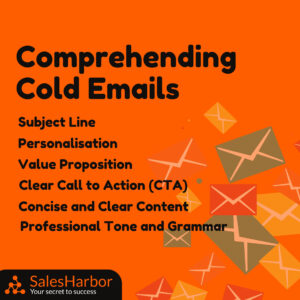
Additional Methods for Sending Out Cold Emails
- Targeting and Segmentation: Divide your email list into groups according to job title, industry, firm size, and other factors. You can boost the likelihood of engagement and more accurately adapt your messaging as a result. Your campaign will be more effective overall if you target particular segments and create messaging that speaks to each group more effectively.
- Follow-ups and Timing: The success of your cold emails can be greatly impacted by their timing. Studies indicate that the most productive hours are usually in the middle of the week, in the morning. In addition, send another message if you don’t hear back. Kindly remind the receiver of your offer by email can be done without coming across as aggressive. Don’t be afraid to contact us again; frequently, follow-up emails will result in a response.
- A/B testing: Test out various email subject lines, content, and call-to-actions to determine which ones your audience responds to the best. Over time, open and response rates can be increased and your strategy can be improved with A/B testing. Your email campaign performance can be greatly enhanced by regularly reviewing the data and making any adjustments to your approach.
- Utilizing Technology: Automate outreach, monitor open rates, and gauge engagement with email marketing solutions. Aside from offering useful data, tools like HubSpot, SalesLoft, and Mailchimp can help you automate your cold emailing process. The likelihood of involvement can be raised by automating tasks to save time and guarantee that follow-ups are sent on time.
- Creating an Effective Email List: A strong email list is the foundation of any effective cold email campaign. Make sure your list contains pertinent contacts and is current. Give your email list some thought and work, and periodically purge contacts who are no longer active or relevant.
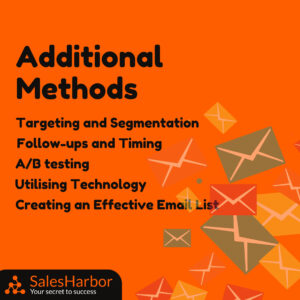
Common Mistakes to Avoid
- Information Overload: If you give someone too much information, they could become overwhelmed. To minimize misunderstandings, keep your email concentrated on a single point or offer.
- Ignoring Recommendations: Be mindful of the input you receive from your users, both good and bad. This may offer insightful information about how people are responding to your emails and areas for improvement.
- Absence of Follow-Up: A lot of possible leads might not reply to the initial email. Remaining persistent and demonstrating interest in collaborating with the recipient through follow-ups can sometimes result in greater outcomes.
- Generic Content: Sending generic, templated emails can lead to low interaction rates. Send out more time-consuming, highly relevant emails by adding personal touches.
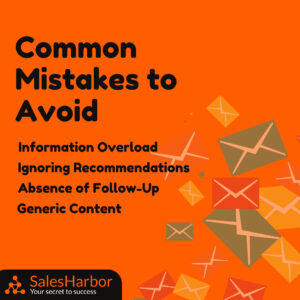
Conclusion
When done properly, cold emails may be a very powerful part of your lead-generating strategy. You may turn cold leads into warm prospects by emphasising personalisation, offering obvious value, and keeping your demeanour clear and professional.
Once you grasp these components, cold emails can be leveraged to generate significant response rates and boost company expansion. Recall that developing connections takes time, and turning cold leads into devoted clients requires perseverance and patience.
If you’re looking for experts who understand this industry and its challenges, reach out to us for a quick intro call and learn more about how SalesHarbor can assist you. We can integrate your desired strategies into your business’s framework seamlessly.


